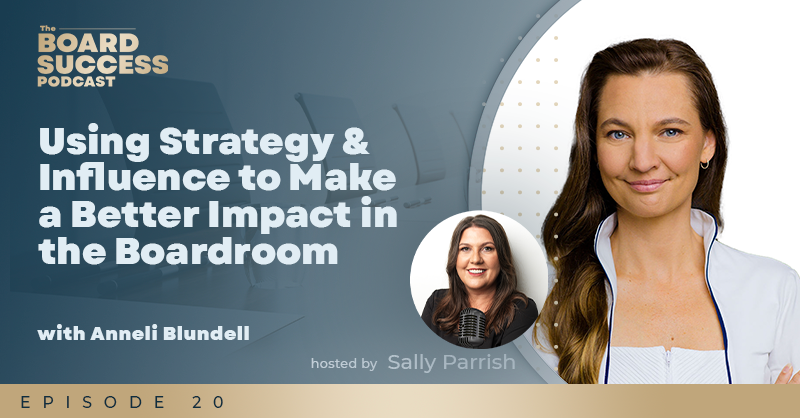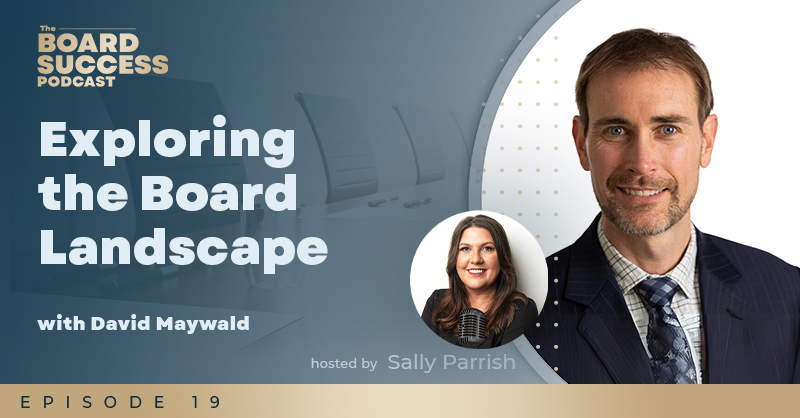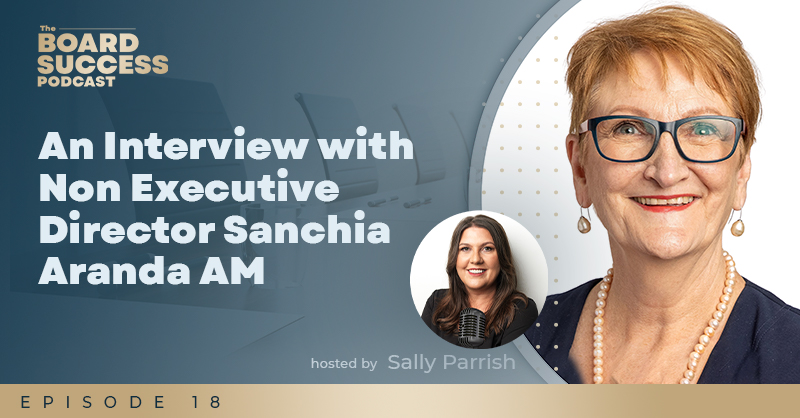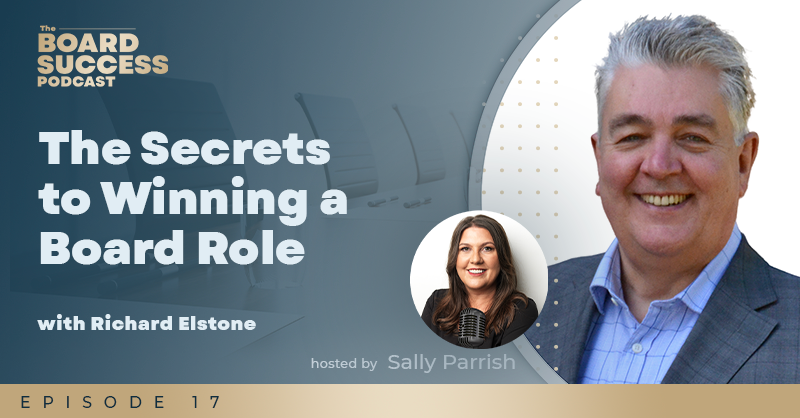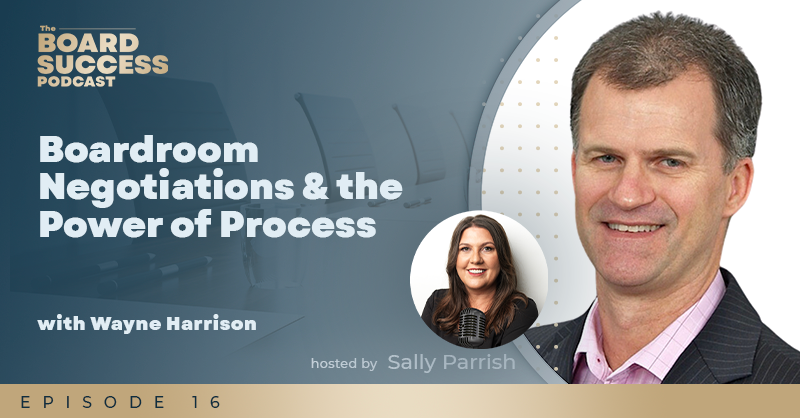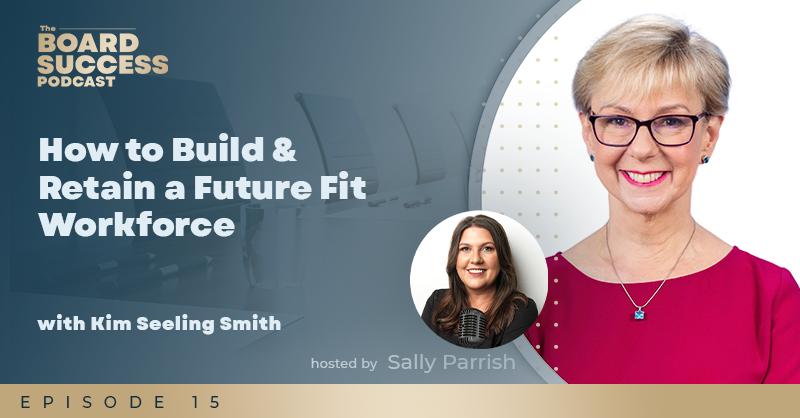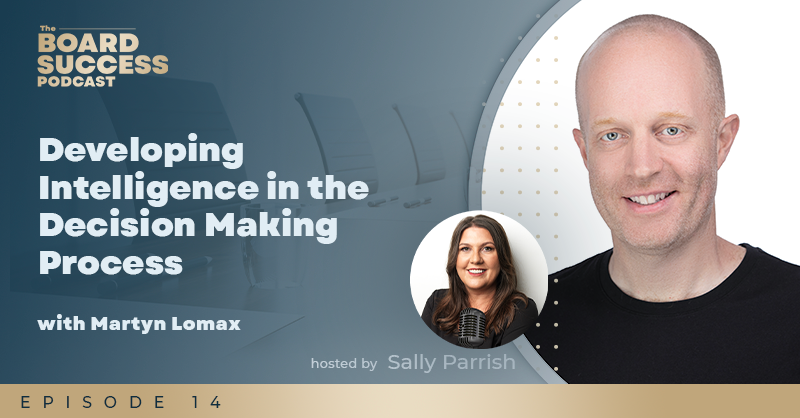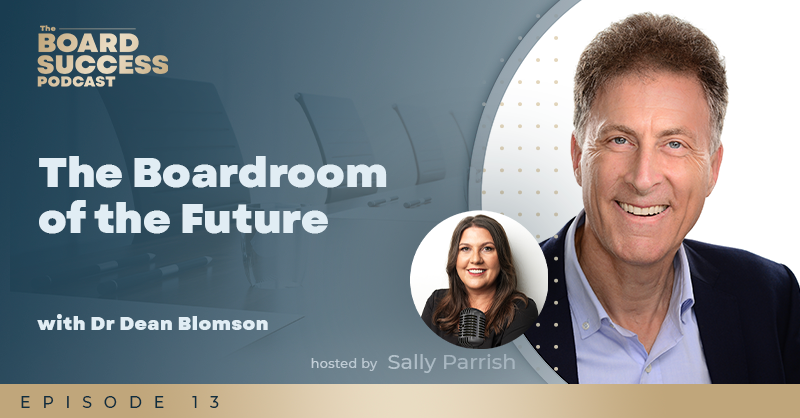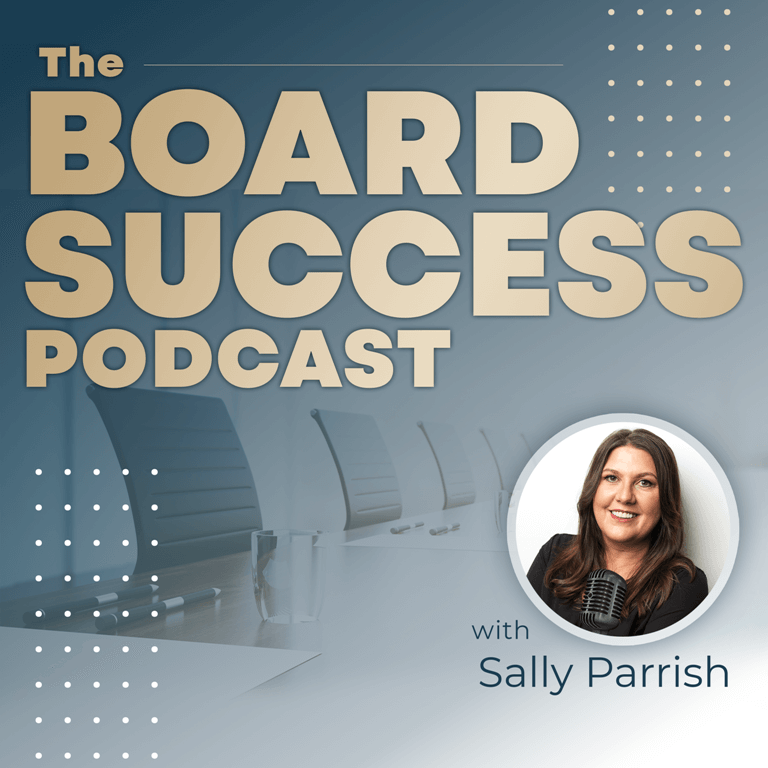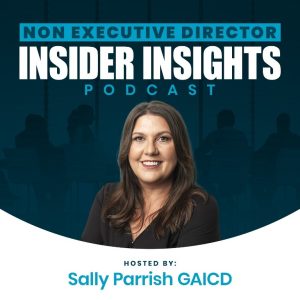Psychological Safety in the Boardroom
with Carolyn Grant
Sally Parrish interviews Carolyn Grant
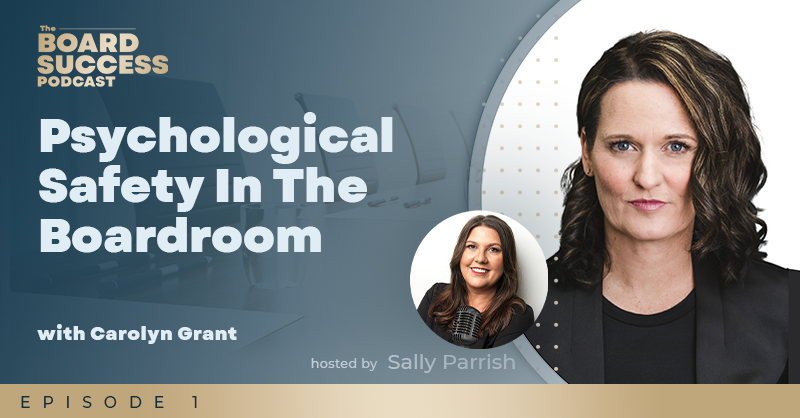
Only 30% of Company Directors feel safe to challenge the status quo on their boards.
Author Carolyn Grant joins us to share the 6 Foundations and 12 Principles from her book Legacy Leadership. Carolyn draws on her personal experience and deep executive research to unpack what does and doesn't work when it comes to creating an effective board environment so that everyone can contribute to the best of their ability.
Within the conversation, we explore the competing needs of shareholders and stakeholders, the customer experience versus the people in the business and what they need to feel safe to engage fully and to the best of their ability.
Carolyn is the Managing Director and founder of 6peas marketing and the People+Science organisational design tools for leaders.
A Marketing Strategist utilising research in neuroscience and human behaviour to create frameworks for Legacy Leaders looking to achieve a sustainable competitive advantage. Our principles are based on delivering a better customer experience with engaged and valued employees (People) united by a Purposeful Strategy (Purpose) to achieve sustainable Profits and Impact.
FURTHER INFORMATION
Meet Carolyn on Linkedin: https://www.linkedin.com/in/carolynmcsweeneygrant/
Check out Carolyn's resources:
Legacy Leadership https://www.6peas.com.au/product/legacy-leadership-ebook/
Research and Findings In 2022 Carolyn and her team published the first 'Boardroom Psychological Safety Benchmark (Australia)' and are committed to conducting and evaluating this research on an annual basis. Highlights of the whitepaper can be found on the website for free. The full whitepaper can be downloaded for $19.95 at https://www.6peas.com.au/resources/
Click Here to View the Podcast Transcript with Carolyn Grant
Carolyn Grant 00:00
If you want advocates as part of your business that are working around the table with you, you've got to have the right environment. Otherwise, I think, you know, in terms of volunteer boards, that's going to be a struggle to get volunteers to spend time and effort that they could be spending with their family or doing something they love to come onto a toxic board. And we haven't even spoken about the legal and regulatory requirements. When you're looking at some of the regulatory and legal environment. This is something that should be at least in that top three.
Sally Parrish 00:32
Hi, I'm Sally Parrish, Amazon, Best Selling Author of the essential Field Guide for company directors and founder of the board Coaching Institute. I've been in on and around boards for over 20 years. And if you like me are passionate about the boardroom, then this podcast is for you. And I'd love you to join me on this mission to decode board success. What is it that sets some non executive directors apart from the rest? How can you enhance your leadership skills so you can be highly effective in the boardroom? And what will it take to make board success reality for you? I hope you enjoy these episodes as much as I love making them and that they unlock the secrets for you to gain a competitive advantage and have massive impact and influence in your board roles. Let's get started. Carolyn, welcome to the podcast. It's really great to have you here. Let's start by if you could introduce yourself, tell us a bit about who you are and what you're working on right now.
Carolyn Grant 01:39
Hey, Sally, thanks so much for having me. So I'm Carolyn McSweeney, Grant, and I am a I didn't want to call myself anymore, I kind of come into organizations to help them solve a lot of their people issues. So I guess the best way to describe myself is this organizational designer that has a marketing and organizational neuroscience background. So what I have essentially been doing over the last three years has been helping building decision making tools and tools to actually help leaders create better environments in their organizations. And sometimes that might be around solving a problem like their employee engagement, or their stakeholder engagement. Other times it might be around psychological safety and driving performance within organizations, or actually just mitigating the risk that they're exposed to that they might not know about as a result of that. So it's, it's really quite diverse at the moment, its workforce strategy, because we're looking at diversity and inclusion, of course, that's one of the first stages of psychological safety.
Sally Parrish 02:43
Yeah, and I think, you know, there's an incredible body of work underpinning what you're talking about there. You know, you talk about I'm, I go in, and I help but the science behind the work that you do, you've developed some amazing tools. For organizations, for boards, I'm looking at Legacy leadership right now. fabulous book, I love the way that you've written this book, because it's really easy to dive into, it's really easy to just get that message. And I think that really is the struggle that we have in our work is that people know what they should be doing. But it's actually getting them to get the message. Sometimes it's the real difficulty. What do you do that really hits home that helps businesses understand why the way that they're behaving is a problem?
Carolyn Grant 03:37
Right, great question. Yeah, thank you for mentioning the book. So I wasn't that book last year, I think it was published. And based on 800 interviews with senior business leaders over eight years as part of a women on boards, future Women Leaders Program. And really, that was talking about what the modern day problems were and what they were seeing and what they had to actually go through. And a lot of that was workforce management. It was having to juggle financial reporting against people reporting, it was simple things like, probably not so simple. But I guess it was the fact that there was so many things that they were juggling at the time that things became quite complex. And then of course, when I started writing it COVID Hit Yeah. And that gave me time to spend more time writing the book, but also, we were seeing a lot more complex issues start to arise. And so we sort of were able to look at what does that mean, under crisis management and what type of things do we need to look at there? But most of the time, what we're solving is really simple communication issues. And its simplest form that we don't know how to have those difficult conversations. Often I'm going in there and that's almost the first thing we're doing, how do we have those difficult conversations and creating a safe space so that the two people that are in that conversation are leaving in a positive way, not a negative way. That's probably one of the biggest challenges that that they were facing. The others were, you know, the big poll against shareholder versus stakeholder who comes first, you know, is it customer? And is it our employees? Or is it the shareholder that's waiting for expectations. And, you know, I think sometimes in the way that we've done our AOC training, you know, shareholder is mentioned an awful lot. And maybe we should be talking stakeholder, which looks at the whole economic situation and the community of stakeholders, as opposed to just one person or one group of people within those stakeholders. So that was always a big challenge for people as well. And then on top of that, you've got multicultural diversity that's happening, not just with our customer base and stakeholder groups, but also our partnerships that we're trying to leverage in terms of suppliers in terms of contracts, because we've got such a global economy, to now our workplaces and the fact that we're in 2022. Now, and workforce issues are a global problem. And we're having to rely on very much a multicultural workforce to actually start filling in those gaps. So, again, when you go back to quality of conversations, how are we making people feel safe in those conversations, when they're from multicultural backgrounds, and all that, of course, leads to psychological safety, which, you know, when I look at some of that research that went into the book, we weren't really using that term we were using, look, people need to be able to speak up, they need to be able to feel safe, they need to be able to trust, we need a level of respect, we need to coach people and mentor them not tell them what to do and how to do it without a change from these leadership styles from command to, to servant or to what we call legacy. But so these were some of the issues that those are even talking about, then. But yeah, always the workforce challenges have been an issue since they died, you know. So that's eight years ago, in terms of this research.
Sally Parrish 07:09
Look, there's a lot to unpack there. One of the bugbears that I have is that we tend to put all of these things that you mentioned into a bucket called soft skills, right. And so they're kind of the easy things that everybody does while they're running a business. But actually, these are the hardest skills, the communications, those critical conversations, that critical decision making, that just providing an environment for everybody to be their best is actually a very high skill. And it takes a lot of work to develop those types of skills. So I get really annoyed when we see soft skills. But also she was speaking I was thinking, you know, we we do talk about helping women find their voice, we do talk about helping women feel like they are being heard. And I think sometimes we just put too much pressure on us as though we're not performing as well as others are or you know, the men are better at speaking than we are. But it's actually coming back to the environment that we're speaking in and how we're being heard. So do you have any personal experience of being in a working environment where you don't feel valued? Where you don't feel heard? Is that where the body of this work is, is coming from? Because you seem to really to get it? You know, I've had experiences in the past where I've just felt sick about some of the conversations that I'm going into, I've been in, in a board meeting where I really have a different opinion to everybody else I've had to grapple with, you know, do I put this opinion forward? Do I speak up? Do I say how I'm feeling and risk being you know, Sally that derails the meeting? Or am I focused on my fiduciary duty? And it's really important that I do it. So what's been your experience experiencing psychological safety, effective communications, feeling valued?
Carolyn Grant 09:13
Yeah. Look, my experience has been the same. And I guess about two years ago, so about 2021, I started doing refresher courses with the AICD and whatever course I could possibly do with the governance Institute, because I was working for all with the banking and finance industry. And I was on a board and advisory to a couple of other boards. And I guess, in one of those situations, I went to a how to optimize performance with the governance is shoot, which was a very good course. But I was running a bit late and so I sort of was taking a moment just to take a breather, and I doodle all the time. So I had my pen in my hand. I was Just listen to conversations that were around me. And there were about four or five tables. And when I started looking down at my sheet of paper, there was this thing going toxic, just horrible chair, don't listen, can't speak up, can't have a conversation finding about minutes not recorded properly, approval processes. And I stopped looking at this going, Oh, my God, what's going on here? What sort of environment? Are we in here? We are supposed to be talking about optimizing the performance of our boards and our organizations. Yes. And the discussion is very much not about that. It's about, you know, this diabolical team that we're a part of that that's just not working. And the dynamics are not right. So I started asking you a few questions. And that was around, well, how safe do you feel in your own boardroom? And that being the boardroom being board members, to committee members, to senior executives, to your executive leadership team, to sometimes it's just a senior management team? So what's this environment that we're creating in a boardroom, which is supposed to be where we're doing our critical decision making? So I started doing my own research, which was quite costly and time consuming. But yeah, it was something that I was really passionate about. So I had studied neuroscience and leadership, and had looked at from a customer perspective, how do we deliver better customer experience? Well, we need to have employees that are engaged, that are willing to problem solve that are, you know, wanting to learn and can share information. And so I kind of went live should be applied in the boardroom, right? And what are the implications if we don't have that safety in the boardroom? So as a result of that, we went out with a huge survey, but I also did a number of interviews with people, and surprisingly, or unsurprisingly, you know, I think four out of 10 said that they felt psychologically unsafe. And when you're looking at this when we talk about women, and absolutely in my position, I think I was really a marketer, if you put me in if you wanted to put me into one position or pigeonhole, I come from a marketing background, really strong CX customer experience, background, and organizational experience. So often, when I went onto a board, it was, well, we want you to be heading up the Marketing Committee. And we want you to focus on all those all those programs that I want to be in, wherever the people are, I want to be if it's in your risk, or if it's in your governance, wherever you position it, if it's around people and optimizing them and mitigating our risks. That's the committee I want to be on. And I think, you know, that goes back to, for us all to feel safe. We like to pigeonhole and stereo type people so that we feel better about ourselves. But we probably need to ask ourselves, well, what's that's got more to do with you than to do with me, right? Yeah. And the interesting thing was on this in a banking and finance arrangement, because I came from the energy industry, I was the only one sitting there that actually had FMR accreditation. So, you know, I was probably one of the most knowledgeable around some of the banking and finance industry at that table at the time. So yeah, it was kind of, you know, this, this need, I think, to make ourselves feel better. And to, to them put everyone in their places that make us feel more comfortable is a really shoe on a board. But the stories that I've also had from men, and the survey that we did, 70% of respondents were men, they felt the same. So a lot of them felt like they couldn't have an opposing position or challenge the status quo, because they were brought on the board with that tap on the shoulder via a colleague or a friend. And they felt like they couldn't challenge that person, because that would be disloyal. So and they were getting quite frustrated with the things that were being run, but didn't feel safe and speaking out, or doing something different. So that to me was something that I'm going okay, this isn't just a female thing. It's not just a minority thing. That interestingly, there were only about 4% that identified as being part of a minority group, whether it be a cultural one or a gender one. So I found that, you know, it's across the board. But I think one of the hardest things to read as part of that research was that only 14% of people that are in these boardrooms, making these decisions actually felt like they were being valued and that their skill sets and their strengths were actually valued as part of that decision making process. And so that when we said to them, well, then how effective do you think the board is at making decisions? Only 25% said that they were highly effective, you know, and I think that's quite scary. And when you look at some of the things that are happening, Dreamworld to the Crown casino to so many different industries that are struggling at the moment, whether it's, you know, companies hitting the wall to boards under pressure and a lot more scrutiny. I think you've got to go back to Yeah, what's the environment? What are we creating? Are we creating one where we, where we are actually appreciating when people challenge it? Or are we sending out a message that's really clear that says, Don't even ask, you know, we don't need, you know, you stick in your spot stay in your square and, and we'll all get along really well.
Sally Parrish 15:20
Yeah, that's really frightening because when you're talking about 14% of people on boards feel that they that they trust the environment, and that they feel safe, that they're in the environment that they're in the average Australian board, you're talking about one person on every board feels like they're in a safe space and a great environment to do their work effectively. So what are some of the challenges that the other people around the board and this, this work applies to all levels in the organization? So we're talking about boards specifically right now, but this could be the executive team, it could be the marketing team, but generally, in a team environment, what are the people who aren't feeling safe, aren't feeling trusted? What are the things that they're experiencing?
Carolyn Grant 16:09
Just to clarify that, that 14% were the ones that when we don't feel valued around the board, yet 30% Said, we've only 30% said we feel safe enough to speak up and to actually challenge
Sally Parrish 16:23
right to 14% don't feel valued 14% Don't
Carolyn Grant 16:27
feel value, but 36% feel they can write can challenge the status quo. But only three out of 10 to 30% actually felt they trusted the people that they were sitting with in that boardroom. So, you know, when we started looking at what's going on, we're kind of going what's the real driver of some of those things. And only 29% said that they felt like information was properly shared around the boardroom table, because knowledge was seen as this position of power. So you know, why would you give that power away to somebody else if, if that was critical to you and your authority, only 27% thought that the board was actually accountable for for decisions and had her strong accountability framework. And I can't tell you how important that accountability is. Because when we talk about psychological safety, you know, we're talking about, do you actually feel like you're part of that team? So do you feel like your skills are valued, and that you're, that you're welcomed? And that you belong? Now second one is, do you actually feel like, you can ask questions. So if we're looking at trying to get an organization who's got workforce issues, where they're actually wanting people to step up, or retrain or upskill, unless they've got an environment to learn, that's not going to happen. And then you need an environment to contribute. So if you want to start looking at innovation in our and we know that we need digital innovation, we know that customers are more demanding, we've got remote workplaces, we've got remote delivery, you know, so we need people to be able to contribute and tell us what's going on and give us feedback. But if you haven't created that environment, you're never going to know what's going on. So the perception starts to widen between what a board thinks they know, and what our customers actually believe. And that that has continued to be an issue for years and years. You know, I think there was a report once that said, something like 97% of the boards think that the customers, you know, love the work that they're doing, and yet only 8% of customers did. So don't quote me on that silly. I think that's wrong.
Sally Parrish 18:35
Wow. Yeah, there's there's an issue around board effectiveness, generally, right boards don't understand how to evaluate how they're doing. And part of that is they don't have the time to do it. You know, no one's busier than the board is. But also it's around what do we measure? How do we measure and you know, I've seen it done really, really badly, where the chair will say, okay, and now on to board effectiveness. Everybody rate us out of 10? How effective do you think we're being and they go around the table? Oh, I think we're in a, I think we're doing really, really? Well, I think we're seven, we're not too bad. But we've got some room for improvement and no actual outcomes or specifics or anything that they can work on. But what your body of work does is allows the board to really get a good sense of where are they at right now. So how are they feeling in terms of their decision making, how they feel in in terms of the conversations that they're having? And all these things are interlinked, right? You talk about innovation, well, we need diversity in order to be innovative, but if we're going to have diversity, then we need inclusion. There's no point having a Noah's Ark approach and to have everything if only the lion gets heard, you know, you need you need that really good variety, but you need that inclusions too. So what does inclusion look like? So all of these things are are interrelated. But what was fascinating for me is that there are a couple of things on the map that are more important than others, if you like, so we were having a great chat about directors insurance and your work has actually identified the boards that are more at risk than other boards have a potential lawsuit? Can you tell us a bit more about that?
Carolyn Grant 20:26
Yes. So I guess when we go in, we look at some Well, I guess, if we looked at what the challenges that people are facing at the moment, number one is workforce issues, or I should say, number one is actually mental health and fatigue. When we I did some research for a year, just looking at medium and large sized businesses, and they said, We're exhausted. We're doing the job of three or four people. So a lot of the mental health and fatigue challenges that they're having are coming from the fact that their workforce is not, it's so we've got workforce issues. Yeah. But when we looked at the third one, you know, it was around these change in transformation and whether they're successful, or the failure of them, and the need to upskill the people that are doing the work at the moment. So when we do psychological safety, and I guess, the assessments and benchmarks that we've developed, so founded in neuroscience, and basically, we try to give leaders the evidence that they need to be able to take action, so that it's everything's based in evidence, but also that it's the simplest and most tailored way forward. Because we can just spend so much money on a scattergun approach, which I think is what a lot of our cultural work is done in the past, but a lot of our engagement surveys have done in the past. But what we do is we look at the neuroscience of the teams and we go, what in particular is going on with this team, specifically, where can we learn from other teams, but in particular, how do we adapt the communication to suit this team here. So it's very much driven by that, and with the leader, and sometimes you could say that the chair is that within the board, you know, 70% of influence on that team performance is based on the latest. So we look at that as well. So when we're going into the boardrooms, what we want is high quality decision making, you know, because when we don't have high quality decision making, we have accidents, we have fair work complaints, we have mental health claims, not only that, we then have customers churning at an astronomical rate, we have our employees leaving at an astronomical rate, we're losing all of our knowledge, and we're losing a lot of our competitive ability, because we're losing our people, we're losing our customers who will go elsewhere. So you know, what we're saying is, let's turn things around a little bit, let's a measure the right thing, you know, you know, it's a real bugbear of mine, let's not measure internally, if we've only got a 20% Trust rate through our leadership team, it's really not a great idea to be doing things internally. If, if people already got trust issues. Yeah, that's the reason that going outside of the organization. So I think we need a little bit of bravery, you know, within our boardrooms, and within our C suite to go right, let's actually see what's going on. I mean, I would certainly want to know about something before the papers do or before the public gets a hold of it, you know, that's when you've lost control of the situation. So if we talk about, you know, in a neuroscience perspective, having some certainty, and actually having some control of the situation? Well, to me, it's about finding out these things before anyone else does and actually looking at resolving them. So that to me is number one. So if I, if I looked at that in terms of then taking that into a boardroom situation, we're often looking at this realignment of strategy that needs to happen. There's so much dysfunction in terms of that at the moment, where the board is saying one thing we'll or we can't even get agreement on it, and then to the execution of it being totally outside of what it is. So I think we need to have more conversations around realigning that strategy, because strategy and purpose are so important that we haven't values conversation, which is what values do we need to be able to deliver on this strategy? And we then what does the behaviors look like around that? So these are all studying the then funneled down into right, if these are the behaviors that we have, these are the things that we need for people to feel inclusive. This gives them the accountability framework around it. psychological safety isn't just being nice. It's having that accountability as well, because without it, you don't know where your boundaries are. So these are things that we're doing with boards and with organizations at the moment. When I look at a couple of years ago, I went to an insurance law conference. And I think the most what's your number one problem and you know, they were having a discussion at the time saying we can't see or forecast some of the mental health issues or kinds that we're getting through. And I guess at the time was going, does it all psychological safety does that do that? And I really think it does. So, we've started to do a lot more work around survey plus we do interviews for context. And at the moment, we're within a 12% error margin to say we believe that within the next six months, these are the following claims that you're going to get now for me, from an insurance perspective, that's critical from an organization's perspective and understanding what your future risk is potentially going to be and how to try and mitigate that before it becomes that that front page news item or before our regulatory environment at the moment is all over psychosocial hazards, you know, and you've only got to look cute once in the paper. And so if those organizations that are getting government grants that are already implementing government programs to me, I'd be you know, I'd be very careful about what I'm measuring and how I'm measuring it. And whether I want to know about it before or after the curio mill, the financial review rear window article,
Sally Parrish 25:57
I think in terms of knowing or not knowing it's often what can I do about it? You know, a lot of the times we don't want to know how bad things are, because there's no sort of remedy. Anyway. So how much of what you do is able to fix some of those problems. So if we see that there's a lack of trust, if we see that there's poor communication, how much of that can be changed? And how much of that is just about, you've hired the wrong people, you need to let them go? Yeah. How would that pan out?
Carolyn Grant 26:25
Yeah, look a lot of the time. Like, I'm, I'm a firm believer that I think HR has this term called on regrettable levers. And I kind of go if we're so strapped for workforce at the moment, it's short, like that should not be a term that is like, you know, relevant. But you know, they're really talking about, I think, those brilliant jerks that kind of bring on, you know, high performers, but are less than human Yeah, and creating really toxic cultures. So I guess there's two ways you can create the norms and the behavior that has, well actually, I'd rather behave and operate in that way. And if that means that we belong, then that's how we start to slowly change the culture, you know, boards set a really clear direction straightaway around the culture by what they ask for what they actually critiquing what they're actually asking questions about what they're actually rewarding, you know, and I think we've got to be really careful about the KPIs and indicators that we're using, which KPIs are we actually rewarding and promoting? Which ones? Are we actually questioning? And how are we questioning it? So we send a really clear message about what's important and not so it has to start there. And that's, I think that's why we've always said it starts from the top, because we're the ones that have to show that curiosity. So are we actually showing that curiosity in the right way, and creating the environment that says, This CEO can absolutely give us everything and no holds barred view of that, because there is no blame here. All we want to do is identify what the issue is, and resolve it together. And with the collective of this room, we have the intelligence, the smarts to be able to help that CEO and his team do the best of their ability. Yeah, absolutely. You know, so I think that's the thing, because otherwise, what we get, and it's really, you know, prominent in government reports is the sanitized report said that, it's what they want to hear. But, you know, I want the other way. I want to know what the issues are so that we can actually start to solve them. And you know, there was great work done by Amy Edmondson, you know, who, whilst she is not the founder of psychological safety, She certainly did a great amount of research. And she started with a lot of clinical governance in hospitals, and had this assumption that the highest performing team in hospitals were the ones that had the lowest reporting of issues, and actually found the opposite, that the highest performing teams were the ones that had identified the issues, and they were reporting on those issues and discussing, how do we solve these issues? How can we do better if patient experience is our number one concern and patient care is what we want to deliver? What can we do differently today that would actually make that better? And what are some of the issues that have arisen that we need to resolve and solve together? Because we are the right people to solve that problem? I love that, you know, and I think that's what we really should be doing across any team.
Sally Parrish 29:33
Yeah, and I think, you know, I really agree. And my mind is just we're in at the moment, Carolyn, because I'm thinking of that, that boardroom it's, the board is faced with so many problems that it needs to solve. It's faced with so many targets that it needs to achieve. It's got the overarching strategy that it needs to perform. It's time poor, but actually that board that can stop and reflect and think about How we doing things around here? What are the environments were created? Just even you were saying there about the executive team sanitizing the reports. And that's an issue that we have in all businesses, right, the exec team present to the board. And I've heard it said before that, if the exec team tells you that things are going really, really well, then things are going great. If the exec team tells you that things are great, then things are okay. And if they tell you that things are okay, we've got lots of problems that you're about to find out about shortly, right. So and that's true, you know, the board are the boss, if you like, and you want to put your best foot forward. But you're all there for the purpose of the business and creating an environment where the exec team can come to the board and say, I don't think you're asking me the right question. Or, you know, we have a real issue coming up, that we're going to need to navigate and not wanting to sanitize those reports not wanting to wear those rose colored glasses. But how much more effective would a board be? If everything the executive team told them was honest and transparent and open? And it would just change the the ability of the board to make a huge difference in their work?
Carolyn Grant 31:15
Yep. And look, a lot of this comes back to then emotional intelligence, which, you know, you and I were discussing before it, there's got to be an amount of self awareness of people and how they understanding how they respond to things and therefore, what type of social intelligence they have, what are they? Do they actually understand the impact that they're having, on others reading that room really well to understand, have we can we still got a safe environment? Or have they are they feeling awkward now, and the other people around the room as well. So that, like, wise for some of the C suite, it's giving them some of that training as well, because at some stage, you've got to go, we've got to own this, we've got to. So until we own it, we can't address it. So if we're still in blaming and shaming, because we don't have any accountability, and we don't have any self awareness, or we're denying that there is still issues because you know, we have low self awareness and low levels of trust, you know, these are sort of the things that we've got to actually get to the bottom of, and that's why those soft skills that we speak about are often the things that are creating issues, because they are people skills and human interactions, and they're so unpredictable. And we all have such different impacts. But yeah, they're really important to think about people's
Sally Parrish 32:42
skills as well is that you just take for granted that everyone has excellent people skills, right, and you only, it's only something you notice if someone does it badly. So if a person is rude, you notice that that person is rude, but you never notice a person for behaving appropriately, you never say, Oh, they behaved appropriately in that meeting today. So it's the thing that we only get to see when it's going badly. And I think that's probably the toxicity that you talked about earlier, things really go off the rails, and then you can see the problem. But for all of us, we can all look at our people skills, our communication skills, our emotional intelligence. And we can all do better in all of those areas. And I guess the challenge that I'd like to throw out today is to create the environment in which you'd like to operate in. So create the environment for the team that you would like for the team that you report to?
Carolyn Grant 33:42
Absolutely, you know, there was a question we asked, and in the survey, and it was, would you recommend a friend or a colleague into that board? You know, would you recommend a friend or colleague to go and work in that year for organization? And there was a really strong correlation. It was point six, nine, I think, in terms of the correlation of that. So if you want advocates, as part of your business, that are working for you, that are working around the table with you, then yeah, you've you've got to have the right environment. Otherwise, I think, you know, in terms of volunteer boards, that's going to be a struggle to get volunteers to spend time and effort that they could be spending with their family or doing something they love to come onto a toxic board whether, you know, and we haven't even spoken about the legal and regulatory requirements here. You know, psychosocial hazards are becoming very, very critical. There's a lot of scrutiny. We've already got a code of practice from New South Wales and Victoria. That means that they've got some attention in this space, but we've got respective work developing at the moment. When we do our psychological safety assessments. We do a change readiness assessment before we go in and do Digital change or any big transformation project before, after a merger or acquisition, you know, we're actually highlighting what's the potential risks that we don't want to be facing in court that we need to mitigate immediately to actually make this organization a success. So when you're looking at some of the regulatory and legal environment, this is something that should be, at least in that top three. And there's not too many things that are on that boardroom agenda, despite the fact that we're that it is a busy place that there are a lot of challenges that don't have human impact, either from a consequence perspective, or, you know, being driven by it. When we look at the workforce issues. When we look at cybersecurity, there's human interaction engagement, when we look at customer experience, when we look at innovation, when we look at, you know, partnerships, supply issues, you know, there's there's a human element everywhere. And so I think we need to start buying Well, on the balance sheet, what impact is this happening? Yeah,
Sally Parrish 36:04
I love that. I love that the human impact the consequences, because it's not just what we do. It's a way that we do it. That's critically important. That's how we're going to be judged. That's how we're going to work together that the, the boardroom psychology, right, it's where you get groupthink, and all of those things, people don't feel safe enough to stand out and stand for their own opinions and their views. So you don't get the robust conversations, you don't get the innovation. So it's all boiling down to how we're behaving together. And I love this, Carolyn, because I think that there are some really great organizations out there that, that teach boards about risk management and governance and financial management and all of those things. But without great human relationships, and great people skills, those fields are never ever, ever going to get the outcomes that they're seeking. So want to congratulate you on your brilliant body of work, I know that you commit to an annual survey that you do, can you tell us a bit about the annual survey that you run?
Carolyn Grant 37:15
Yeah, so the annual survey is the psychological safety in boardrooms. So generally, we ask for any board member or committee member C suite executives to frontline employee to participate if they're involved in some of those boardroom decisions. So we'll be sending out the link for the second one. But yeah, that's a great report. It's got a white paper attached to it. But anyone can download the highlights from the website for free. But the white paper goes into some of the consequences and looking at what are the implications of some of this? And yeah, the discussions that we've had have been wonderful when we talk about some of the impacts. You know, when you're having these conversations, you learn so much, and you learn just how many mistakes were making, because we haven't got clarity around our strategy and around our conversations.
Sally Parrish 38:06
Yeah, I love that. I love that this is a real, a tool, a framework that any board director that any senior manager can use to instantly upskill and and we talked about the book earlier legacy leadership, what a great framework, I mean, broken down into what to do and how to do it, how to know when you're not doing it, what the consequences are. This is a brilliant handbook. So thank you very much for the time that you put in putting all that information together and making it simpler for the rest of us. I will put details in the show notes for the book for the white paper for your LinkedIn, I feel like we've only just scratched the surface. So I feel like I've got at least another 15 bullet points that I wanted to cover today. So I would love it. If you come back on the podcast later on in the year, Carolyn, because I think this is a topic that we could just keep unpacking all of
Carolyn Grant 39:00
the time. Yeah, I'd be happy to. I learn from it every time. You know, there's always something different. In the survey. I'm always asking you questions, the legacy leadership book, I think it's you know, every time I have a conversation with a new leader, they're giving me new pointers, new tips, different ways of doing things. And they're so willing to share and to talk about their experiences. So I love where that book has started in having those six core principles. And I guess the foundations and then the 12 principles are about Yeah, we are under stress. We are constantly challenged, we have got things being thrown at us. But how do we stick to that TrueNorth without slipping because, you know, as you know, in ethics, you know, once you've made that excuse the first time it's really easy to keep going downhill from there and ease and lose all sense of accountability. You know, we're able to justify so many things. So, so that's what the top principles were about the six cores will like have this as your foundation and a bare minimum work on this as your leadership competencies. But the principles are kind of guide you when you feeling, you know, exhausted when you're feeling down when you feel like you have got those mental challenges that are just depleted. How can we actually stay? Of course, yeah, as a team really?
Sally Parrish 40:25
Yeah. And I think sometimes you just don't know where to start. And what your book does, is gives everyone a starting point. So whether you start with, you know, the psychological safety, or whether you start with the emotional intelligence, or just here we focused on here, is it the stakeholder Is it the shareholder, it just gives everyone a starting point to come back from wherever they're at. So when it whenever they're feeling exhausted, whether they're feeling stuck, it's gonna give them the turnaround and the next step in their own personal professional development. Thanks very much for joining us today. Carolyn has been absolutely wonderful to unpack some of these mind blowing statistics. I think everyone has the perception that boardrooms are very well run, and they're, you know, the best leaders in the country. And they're all sat around getting on really well together. But we know that's not the case. And this is really, really great work with building the boardroom of the future that we all want to see. So thank you very much for your work. And thanks for joining us today.
Carolyn Grant 41:26
Thank you. Thanks.
Sally Parrish 41:29
Thanks very much for tuning in. I'd love to know what you thought of this episode and what you took away from it. I'd also love to know what topics you're interested in hearing about in the future, and which experts you think should be featured on this sports success podcast. If you enjoyed listening, please share with your colleagues who might also have an interest and make sure you click to follow us subscribe to be advised about upcoming episodes. In the meantime, if you're a leader or a successful executive, and you're looking to launch your board career, or if you're an established non exec director, and you're ready for the next level, check out the resources we have available for you on the website at board coaching institute.com.au. Until next time, here's to your board success!
Explore more episodes
